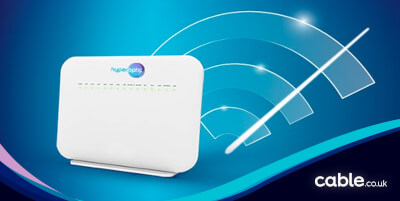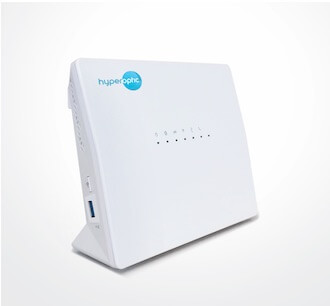Hyperoptic broadband review 2024: Is it any good?
 Dan Howdle • July 24th, 2024
Dan Howdle • July 24th, 2024

Hyperoptic is an ‘altnet’ broadband provider that has built it's own ‘full fibre’ network in parts of the UK, but is it any good?
Results of our broadband survey
We interviewed 6,000 household broadband decision makers in 2021. This is how Hyperoptic broadband customers rated their service:
| Installation/switching | |
| Speed satisfaction | |
| Reliability |
| Equipment/routers | |
| Value for money | |
| Likeliness to recommend |
Our review of Hyperoptic broadband
Hyperoptic is part of a new wave of so-called 'altnet' (alternative network) providers offering gigabit-speed, full fibre broadband. It does this using its own network and has a strong focus on apartment blocks in big cities. It is ludicrously quick, but also incredibly unlikely you will be able to get it due to its small national footprint. But if you can, is it any good?
Reasons to buy
- Very fast broadband
- Symmetrical download and upload speeds
- You don’t need a phone line
Reasons to avoid
- Very limited availability
- No freebies
- No TV bundles
Overview
Here’s a quick look at what you can expect to find in a Hyperoptic broadband package.
| Average download speed | 50Mbps – 900MbpsGbps |
|---|---|
| Average upload speed | 5.7Mbps – 900Mbps |
| Broadband | Fibre |
| Home Phone | Yes |
| Prices from | £17.99 per month |
Broadband speeds
Most of the UK’s broadband is delivered using copper for at least some of its journey from the cabinet to your home. But Hyperoptic uses fibre for the whole of its network, boosting speeds and capacity far beyond what anyone else can offer.
Hyperoptic’s entry-level product provides 50Mbps download speeds, which is ideal for a household with a few devices for streaming, online gaming and general web use. Hyperoptic also offers a 150Mbps service and a 500Mbps service, which provide capacity for more users and 4K streaming, with quite a bit to spare. (Take a look at our guide to work out what broadband speed you might need.)
The real head-turner, though, is the 900Mbps package (misleadingly called 1Gb Hyperfast). It's still faster than anyone needs, but interestingly no longer the fastest broadband in the UK, with EE Broadband and Vodafone Broadband both offering 1.6Gbps Full Fibre and Virgin Media continuing to offer its Gig1 (1130Mbps) package and just starting now to roll out Gig2 (2Gbps).
Be aware that Hyperoptic states that its advertised speeds are dependent on you connecting your devices directly to its Hyperhub router using wired ethernet connections and that wifi speeds will depend on the device you're connecting with.
According to Ofcom’s 2023 data (Ofcom data is more often than not over a year behind the present date) The median average actual download speed of UK residential fixed broadband services is 69.4Mbps, so this is a huge upgrade. Although 900Mbps is among the fastest broadband speeds available in the UK, Hyperoptic is by no means unique in this regard.
Hyperoptic’s bundles are available on rolling contracts but if you commit to 12 or 24 months there are savings to be had. Either way, there is a £19 activation fee to pay, which rises to £29 or £39 if you opt for one-month rolling. Just bear in mind that availability is very limited. You can check if you can get Hyperoptic via its website. If you can’t get it, your best chance at ultrafast broadband is Virgin Media.
Upload speeds
With many providers, the upload speed is a poor relation to the download speed. One of the beauties of fibre to the premises (FTTP) – the type of fibre used by Hyperoptic – is that it can offer symmetrical speeds. That means the download and upload rates are the same.
Although the 50Mbps service offers a meagre 5.7Mbps upload speed, the other packages offer upload speeds that are the same as the download speeds. This is a godsend if you regularly deal with large files such as video or audio.
-
 Total saving £10350Mb Fibre Broadband Only
Total saving £10350Mb Fibre Broadband Only- 57Mb average speed +
- Unlimited usage +
- No phone line
- No Upfront Costs – Save £19
£23.50 per month(usually £27.00)Total saving £103£0 one-off cost24 month contract -
 Save £103150Mb Fibre Broadband Only
Save £103150Mb Fibre Broadband Only- 158Mb average speed +
- Unlimited usage +
- No phone line
- No Upfront Costs – Save £19
£23.99 per month(usually £27.50)Save £103£0 one-off cost24 month contract -
 Total saving £67500Mb Fibre Broadband Only
Total saving £67500Mb Fibre Broadband Only- 522Mb average speed +
- Unlimited usage +
- No phone line
- No Upfront Costs – Save £19
£31.00 per month(usually £33.00)Total saving £67£0 one-off cost24 month contract
Compare Hyperoptic broadband Call us 0333 210 1160
Router and installation

All broadband packages come with the same top-end Hyperhub. The Nokia Hyperhub was provided with 500Mbps and 1Gbps packages. It was dual-band and four gigabit ports which will support up to 1Gbps speeds over a wired connection. You won’t get the very top speeds if you go wireless.
Installation
Hyperoptic is fast, but can you get it? Hyperoptic’s full fibre network now passes a million homes and businesses.
Hyperoptic invites landlords and residents to express an interest. It also works with councils to bring gigabit broadband to social housing. And it has partnered with more than 100 home developers. Hyperoptic has plans to reach five million within a decade, but you’ll need to be patient.
If you are lucky enough to be covered, then installation is a bit different to most providers. Because Hyperoptic doesn’t use the Openreach network, its engineers will need to install a separate ‘Hyperoptic Socket’ inside your home. Installation generally takes an hour and engineers will install a socket up to 10 metres from the entrance. If you want the socket any further into your home, you’ll have to pay a bit extra.
If you want to connect a whole building, this will take a little longer. Hyperoptic will assess the building to see if it is viable and seek permission from the freeholder or building management company. If all is well, the process will take four to six weeks.
Customer service
If you do have any problems, then Hyperoptic has a 24-hour customer support team available on 0333 332 1111 that handles anything from router problems to connection issues. Alternatively you can use the Live Chat service, or send an email to support@hyperoptic.com. As with most broadband providers, there are some complaints about delayed or missed engineer visits, but in general the feedback is positive. It seems Hyperoptic’s speed has inspired a degree of customer loyalty.
It’s worth pointing out that you don’t need a phone line to get Hyperoptic. But if you want to pair your broadband service with a home phone, you can. Calls are made over the internet using VoIP technology. This means the quality should be high but if your broadband goes down, you won’t be able to make calls.
Broadband near you
Cable.co.uk's broadband postcode checker will find you the best deals, providers and speeds where you live. It's free and takes less than a minute to check and compare.
Our verdict: Outstanding
The fact that Hyperoptic offers gigabit speeds will be enough for some people, provided they can get it. Especially those who deal with large file uploads, or those simply desperate to get away from BT Openreach. Even better, its packages are pretty affordable, even when compared to more conventional fibre rivals.
It’s a shame there are only meagre savings on offer for those who don’t want a home phone. Given the Openreach network is bypassed entirely, the absence of line rental and phone charges would be a huge selling point for a generation that is ‘cutting the cord’.
It’s also worth pointing out that most web users won’t actually need 1Gbps, or even 150Mbps. So is the increased cost worth missing out on bargain TV services and free Wi-Fi from other providers? But the biggest issue is coverage. Hyperoptic might have big plans in the works, but for now it’s very limited when compared to the national scale of BT and Virgin Media.
